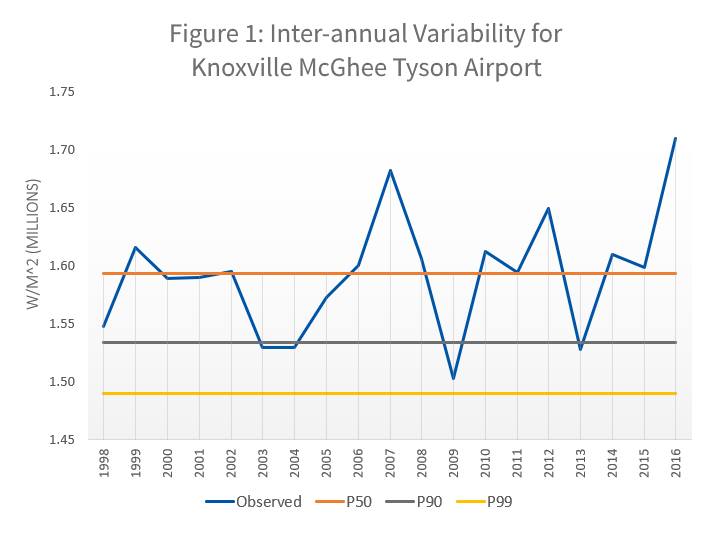Until now, SolarAnywhere® has offered two types of data: time-series and typical year (TGY). Today we’ve added a third option, probability of exceedance, or PXX for short. The “XX” refers to the probability that the level of irradiance will be exceeded in a given year. SolarAnywhere PXX files make it easier and faster to calculate your project’s PXX energy yield.
Debt providers commonly finance only the level of debt that can be covered by the energy sales in a low irradiance year (see for example P90 or P99 irradiance in Figure 1, below). Financing terms can decide the viability of a project. Therefore, it’s imperative to consider how the powerplant performs in that scenario.

Streamlined Analysis with SolarAnywhere PXX
There are several methods for estimating PXX energy. A typical method is to simulate the full time-series (e.g., the twenty years of weather data available from SolarAnywhere) and fit the annual totals to a probability distribution.1 Unfortunately, while standard PV modeling tools now support time-series simulations, such investigations are time intensive.
Alternatively, it’s possible to use typical year data and input the characteristics of a distribution in the PV modeling tool. However, the method is opaque without a specialized understanding of statistics, the simulation model and the underlying weather data. Worse, the assumptions may not be representative of the data or withstand the scrutiny of the independent engineer.
With SolarAnywhere PXX files, solar professionals can model inter-annual variability with the convenience of typical year simulations. This reduces the time and cost to arrive at the PXX energy estimate. You specify the probability (e.g., P90) and SolarAnywhere returns a representative weather file with 8760 hourly values that can be imported into any PV modeling tool.
PXX files also aid project design optimization by streamlining the analysis of how each design alternative performs in low, typical and high irradiance years. While one design might perform best in a typical year, another design might squeeze more energy from poor weather and improve financing terms.
Improved Probability of Exceedance Methodology
What’s more, SolarAnywhere PXX files use an improved method for calculating probability of exceedance that better represents assymetric irradiance distributions and weather risk. Higher quality data reduce the risk of unnecessarily conservative or costly financing.
PXX data are available in the web user interface and the API, and are included with a Time-series licenses (not available with Academic licenses). To explore the topic in depth, click here, or contact us for a demo.
